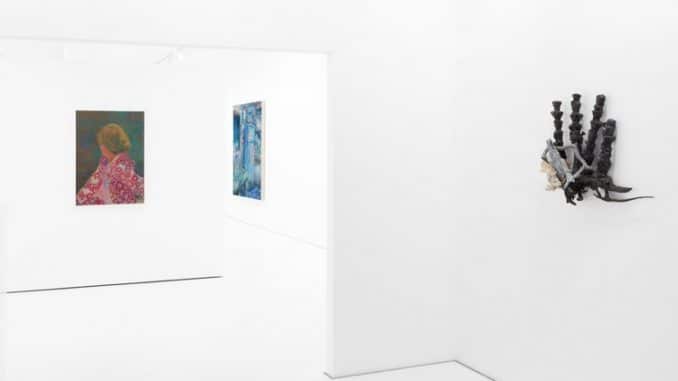
Jack Barrett is pleased to present Latent Rhythm, a four artist exhibition featuring new works by Taha Heydari, Yein Lee, Yanjun Li, and Erik Nilson. Spanning both sculpture and painting, the works in Latent Rhythm touch on themes of generation and decay, and cause and effect––the chain reaction of changes both visible and imperceptible. They acknowledge the compounding decisions that led to their existence, and capture yet another moment on the precipice of change.
Baltimore-based painter Taha Heydari, born in Iran in the wake of the Islamic Revolution, investigates personal, political and technological instability. His practice aims to deconstruct the binaries that have shaped his identity: East and West, body and soul, past and future.
As a digital miner of the Internet, Heydari creates compositions that reference sourced online imagery, often using images that have been pre-modified through various technologies such as Photoshop or AI generation. In his paintings, machine-like grids, indicative of both pixels on a screen and the woven threads of a Persian rug, overlay gestural marks.
In 12 Volt, a crowd is seen gathering around a small television resting atop the hood of a car, powered by its battery. Referencing a photograph from the beginning of the Islamic Revolution, the image marks the impending uprising, catalyzed by the broadcast of Khomeini’s national address in 1979. The car, a technology in itself, has become the power-source for transmitting a message through the medium of television. This speaks to the ways in which information is mediated by technology, a topic especially pertinent in the current political climate, with news being not only mediated but manipulated through online channels.
At once skeletal and humanoid, Vienna-based Yein Lee’s sinewy steel sculptures, titled “Feelers,” bend and transform in space. Again alluding to our interconnectedness with technology, Lee’s sculptures explore our ever-increasing reliance on tech as a means of communication. The antennae-like limbs of the “Feelers” reach and protrude in unexpected directions, as if attempting to transmit and receive signals. If the sculptures are figures of sorts, the accompanying paintings on galvanized steel are speculative records of the movements and transmissions of those forms––the echoing waves depicting how their signals might travel in an attempt to communicate.
In Yanjun Li’s paintings, rippling forms appear to emanate in all directions, like light dancing across water. Using the language of abstraction, Li explores the intangible forces capable of transcending barriers of written and spoken communication. In this sense, the works are a visual expression of the energy emitted between beings–the oscillating frequency of human connection that goes beyond the limits of language.
New York-based sculptor Erik Nilson fuses found and fabricated objects to create new, hybrid configurations. Meticulously joining together seemingly disparate specimens––everything from found metals and wood, to broccoli stems and chicken bones––the resulting forms are at once familiar and otherworldly, like relics of a not-so-distant past or future.
Nilson’s Drogue III anchors the lower level gallery, much like a drogue (wind anchor) is used to steady the hull of a boat during severe storms. The 10 foot sculpture, an amalgamated form composed of driftwood and other found materials, appears as if unmoored, collecting detritus from the ocean in its path. What we see seems like only a portion of a much larger structure–like the tip of an iceberg, or the bow of a sinking ship.
October 27 – December 16 | Jack Barrett Gallery, 89 Franklin St, New York | More information here